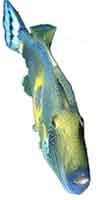 |
|
 Located near Apollo Bay close to the shore at Marengo, this sanctuary covers 12 hectares, comprising two small reefs that provide for a wide variety of microhabitats. Protected conditions on the leeward side of the reefs (unusual for reefs on this high wave energy coastline) allow bull kelps and other seaweed to grow densely. There is an abundance of soft corals, sponges and other marine invertebrates. Located near Apollo Bay close to the shore at Marengo, this sanctuary covers 12 hectares, comprising two small reefs that provide for a wide variety of microhabitats. Protected conditions on the leeward side of the reefs (unusual for reefs on this high wave energy coastline) allow bull kelps and other seaweed to grow densely. There is an abundance of soft corals, sponges and other marine invertebrates.
The sandstone reefs that are within the Marine Sanctuary are known as Little Henty Reefs and are about 80 metres offshore from the beach. Both reefs are clearly visible at low tide and at high tide the tops are still visible.
Due to the location and configuration of these reefs, a wide variety of microhabitats are present in a very small area. The remote location of these islands has ensured that they are packed with sea-life. A rich intertidal reef lies along the top of the sandstone islands. |
 |
Geological, Hydrological and Landform Features
Henty and Little Henty Islands have been flattened over thousands of years by the waves and now barely show above the surface. The topmost parts of the reefs are exposed at low tide and still visible at high tide. The substrate is relatively smooth cretaceous sandstone surrounded by sand. The reef edges consist of crevices and ledges contributing to habitat diversity.
Average depth around the reefs is 5 metres with a depth range to approximately 16 metres. The northern side of the reef is protected from prevailing swells. Strong currents flow in the channel between the reefs. Because of their configuration, the reefs provide a wide variety of microhabitats in a small area. It is the only offshore reef sheltered from prevailing swell along the Great Ocean Road between Anglesea and Peterborough. |
| |
|
|
 |
Things to Do
The reef offshore from Marengo is a great destination for snorkellers when conditions are suitable. A short swim from the beach, the reef supports extensive beds of bull kelp which in turn host a wide diversity of smaller red and brown algae and a wealth of invertebrate life.
The shelter provided on the inside of the reef makes conditions suitable even for beginner snorkellers on a good day. |
|
Outside the protection of the reef the exposure to ocean swell creates a more dynamic environment better suited to experienced snorkellers and divers.
The sanctuary is only a short drive along the Great Ocean Road from Apollo Bay, where there are full services, including boat launching facilities and a Visitor Information Centre. |
|
Facilities
Marengo township has camping and accommodation available. Nearby Apollo Bay has a full range of facilities.
|
|
Heritage
Local Aboriginal communities have accessed the area in the past for traditional uses of food gathering. Shell middens may be found in the surrounding coast although extensive survey work has not been carried out.
Two shipwrecks have been identified within the Marine Sanctuary including the Grange which was lost in 1858.
|
|
The Grange, an international trader from Scotland, was lost due to a navigational error. The Grange was a 3-masted wooden hulled barque that was transporting ballast material when it struck the reef on its trip from Melbourne to Guam after mistaking the lights from Apollo Bay as the Cape Otway lighthouse. The other was the Wollomai, a local trader of the local mosquito fleet, that was wrecked in 1923 when it was blown ashore in a gale. |
|
Aboriginal Traditional Owners
Parks Victoria acknowledges the Aboriginal Traditional Owners of Victoria - including its parks and reserves. Through their cultural traditions, Aboriginal people maintain their connection to their ancestral lands and waters. |
|
 Fauna
Fauna
Six Spined Leatherjacket (Meuschenia freycineti)
The Six Spined Leatherjacket are mostly solitary on the reefs, but the species come together in large schools during the breeding season between late winter and autumn. During this time, males vie for dominance and it is not uncommon to see two approach head on, their dorsal spines in full display. Males will use their tails to hit and slash at each other |
|
using the well developed set of curved spines at the front of the tail. This can leave serious wounds despite the leatherjacket?s tough skin. Juvenile Six Spined Leatherjackets are abundant in seagrass beds.
Adult leatherjackets are found in the kelp forests of Marengo Reefs, where they feed on sea urchins and shellfish. Australia is the focal point of leatherjacket diversity. Of the 97 species found worldwide, 60 inhabit Australian waters, with 22 found in its southern waters.
|
|
Precautions
For your own safety, only undertake activities appropriate to your skills and abilities. Take all necessary precautions, be aware of changing conditions, and watch for potential hazards, such as rips. A number of Victorian marine animals are potentially harmful if not treated with respect and care, so ensure that you familiarise yourself with these species. Sunburn and hypothermia are also potentially harmful but easily avoided.
|
|
SCUBA diving is a potentially high-risk activity and should only be undertaken by appropriately qualified people that have completed recognised training and certification. Victoria?s cool water environments can be extremely challenging to those used to diving in warmer waters so ensure that local knowledge is sought before undertaking a dive in a new location. Dive charter operators can provide some of the best advice on diving in Victoria.
|
| |
|
|
| |
|
|
| |
|
|
| |
|
|
